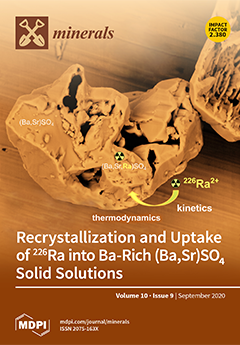In this contribution, we report the metasomatic characteristics of a lamprophyre dyke–marble contact zone from the Hongseong–Imjingang belt along the western Gyeonggi Massif, South Korea. The lamprophyre dyke intruded into the dolomitic marble, forming a serpentinized contact zone. The zone consists of olivine, serpentine, calcite, dolomite, biotite, spinel, and hematite. Minor F and Cl contents in the serpentine and biotite indicate the composition of the infiltrating H
2O-CO
2 fluid. SiO
2 (12.42 wt %), FeO (1.83 wt %), K
2O (0.03 wt %), Sr (89 ppm), U (0.7 ppm), Th (1.44 ppm), and rare earth elements (REEs) are highly mobile, while Zr, Cr, and Ba are moderately mobile in the fluid. Phase equilibria modelling suggests that the olivine, spinel, biotite, and calcite assemblage might be formed by the dissolution of dolomite at ~700 °C, 130 MPa. Such modelling requires stable diopside in the observed conditions in the presence of silica-saturated fluid. The lack of diopside in the metasomatized region is due to the high K activity of the fluid. Our log activity K
2O (a
K2O)–temperature pseudosection shows that at a
K2O~−40, the olivine, spinel, biotite, and calcite assemblage is stable without diopside. Subsequently, at ~450 °C, 130 MPa, serpentine is formed due to the infiltration of H
2O during the cooling of the lamprophyre dyke. This suggests that hot H
2O-CO
2 fluids with dissolved major and trace elements infiltrated through fractures, grain boundaries, and micron-scale porosity, which dissolved dolomite in the marble and precipitated the observed olivine-bearing peak metasomatic assemblage. During cooling, exsolved CO
2 could increase the water activity to stabilize the serpentine. Our example implies that dissolution-reprecipitation is an important process, locally and regionally, that could impart important textural and geochemical variations in metasomatized rocks.
Full article





